Flocculation of Ulva microscopic propagules using modifi ed clay: a mesocosm experiment*
LI Jing , SONG Xiuxian , , , FAN Xin , YU Zhiming ,
1 CAS Key Laboratory of Marine Ecology and Environmental Sciences, Institute of Oceanology, Chinese Academy of Sciences, Qingdao 266071, China
2 Laboratory of Marine Ecology and Environmental Science, Qingdao National Laboratory for Marine Science and Technology, Qingdao 266237, China
3 University of Chinese Academy of Sciences, Beijing 100049, China
4 Center for Ocean Mega-Science, Chinese Academy of Sciences, Qingdao 266071, China
Abstract Microscopic propagules of Ulva species (UMPs) spread on Subei Shoal are believed to play a signifi cant role in the formation of the Yellow Sea green tide. Previous laboratory and ship-based studies indicated that modifi ed clay (MC) can effectively remove UMPs from the water column and restrict their germination. To evaluate the effectiveness of this method under natural conditions, a mesocosm experiment was conducted on the Zhugensha sandbank on Subei Shoal. The results show that the suspended particles on the sandbank would partially disturb the flocculation process between the MC and UMPs. However, the MC at a proper dose could effectively remove UMPs from the water column and decrease the adhesion and germination of UMPs on the nylon ropes that comprised the mariculture rafts by >75%. This method was proven a potential strategy to restrict the initial biomass accumulation of green algae on Subei Shoal. However, fi eld trials in larger time-space scales are still needed to assess the efficiency of this method when used in the open sea.
Keyword: green tide; Ulva; modifi ed clay; microscopic propagules
1 INTRODUCTION
“Green tide” has resulted in serious ecological and economic impacts on the coastal areas of Jiangsu and Shandong Provinces, China (Le Luherne et al., 2017; Song et al., 2018). Microscopic propagules of Ulva species (UMPs) have generally been accepted as the “seeds” of the green algae that has occupied the southern Yellow Sea every summer since 2007 (Lin et al., 2008, 2009; Ding et al., 2009; Gao et al., 2010, 2014; Pang et al., 2010; Keesing et al., 2011; Ye et al., 2011; Liu et al., 2013a, b). The so-called Subei Shoal, which is located on the shelf of the southwestern Yellow Sea and off the coast of Yancheng and Nantong, is a sand ridge that covers an area approximately 200 km long and 100 km wide. The shoal provides a habitat for over 20 000 ha of Porphyra mariculture rafts, which are ideal adhering base for UMPs (Liu et al., 2010a). Previous studies demonstrated that UMPs were widely distributed around this area prior to and during the appearance of green tides, with the highest density reaching 4 800 ind./L (Liu et al., 2010b, 2012, 2013b; Huo et al., 2014; Li et al., 2017). Small UMPs adhere to, germinate and grow on the nylon that comprises mariculture rafts, gradually develop into approximately 4 900 t of the initial biomass of green tide (Liu et al., 2009, 2010a). These green algae seedlings are detached from the rafts and discarded along the coast when Porphyra are harvested, after which they float into the southern Yellow Sea with tide and keep growing as floating northwards, eventually form the greatest green tides ever reported (Liu et al., 2013a, b, 2015; Geng et al., 2015; Zhou et al., 2015a, b). In an attempt to reduce the initial biomass accumulation of Ulva species on Subei Shoal, removing UMPs from these waters to prevent them from adhering to mariculture rafts has been regarded as a potential strategy to alleviate the Yellow Sea green tide (Liu et al., 2012, 2013a; Li et al., 2016, 2017).
Presently, modifi ed clay (MC) technology is the most widely used method for the mitigation of harmful algal blooms in the fi eld in China (Yu et al., 2017), which has also been introduced to the United States, Chile and other countries in recent years. Based on more than 20 years of laboratory studies and fi eld applications, this method has been verifi ed as being highly efficient, low cost, and easy to apply (Yu et al., 1995; Lewis et al., 2003; Sengco et al., 2005; Mei et al., 2010; Wang et al., 2014; Li et al., 2017, 2019; Yu et al., 2017). In Lake Xuanwu, Nanjing, China, 300 t of MC was applied over the lake area during a Microcystis spp. bloom in the summer of 2005. The bloom was terminated, and the amount of phytoplankton was reduced, while the community species increased after the treatment (Mei et al., 2010). Since then, MC as an emerging method of harmful algae bloom (HAB) control has been successfully practiced in more than 20 waters along the coast of China. In 2014, MC was included as a standard method in the “Technical Guidelines for Treatment with Red Tide Disaster” in China (GB/T 30743-2014) (Yu et al., 2017).
The size of Ulva propagules (zoospores, gametes, zygotes, and microscopic germlings) ranges from 6.2 to 12.4 μm (Wang et al., 2007), which is similar to that of many microalgae species. A previous laboratory study found that the removal rate of MC at a concentration of 0.4 g/L for Ulva prolifera microscopic propagules at a density of 4.8× 105cells/mL was 80%, and that treatment with 1.0 g/L of MC could decrease the germination rate from 60% to <6.5% (Li et al., 2015, 2017).
However, Subei Shoal, which is comprised of a large number of radial sand ridges, is an extended intertidal mudflat region that is exposed at low tide and submerged at high tide (Liu et al., 2010a, b). This unique hydrological characteristic causes the seawater in this area to contain a large number of suspended particles. The main mechanism of using MC to mitigate HABs is to flocculate algal cells that have negatively charged electrostatic surfaces with positively charged clay particles (Haydon, 1961; Yu et al., 1994, 2017; Pieterse and Cloot, 1997). Accordingly, it is suspected that the suspended particles in the area of Subei Shoal would disturb this process.
Therefore, in this study, a mesocosm experiment was conducted on the Zhugensha sandbank on Subei Shoal to examine the effectiveness of using MC to remove UMPs and prevent them from adhering to nylon ropes under natural conditions. The particle characteristic of the MC solution and seawater from the experimental area were also studied to identify the underlying mechanism involved in the flocculation process.
2 MATERIAL AND METHOD
2.1 Study area
Zhugensha sandbank (121°17′36.5994″E, 32°47′17.52″N), which is located off the coast of Rudong County, Nantong City, Jiangsu Province (Fig.1), is one of approximately 70 sandbanks on Subei Shoal. Approximately 1 500 Porphyra mariculture rafts were placed on this sandbank in 2016–2017, each of them supports 30–36 sets of mariculture net curtains.
2.2 Mesocosm construction
The mesocosms were custom-made cylinder fi berglass tanks that were 1.6 m in depth and 1.6 m in diameter and had a volume of 3 200 L. Handles were attached to the walls of the mesocosms to fi x them in place. As shown in Fig.2, the mesocosms were tied to rafts from which the Porphyra mariculture nets had been removed. Seawater was pumped into the mesocosms to a depth of approximately 1 m, so that they would float on the water when the outer water level was high and sit on the sandbank at low tide. Eight tanks were used in this study, including two replicates for each of the 4 MC doses as mentioned in Section 2.5.
2.3 Preparation of the adhering base
Used nylon ropes were collected from the seaweed mariculture rafts on the Zhugensha sandbank (Fig.1), cut into 15-cm long stems, and sterilized for 30 min to remove any UMPs or microorganisms that were already attached.
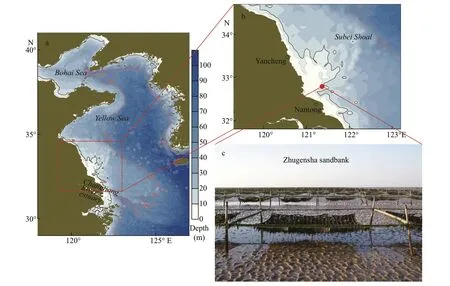
Fig.1 Maps of Subei Shoal (a, b) and Porphyra mariculture rafts on the site at low tide (c)

Fig.2 Aerial photographs of the mesocosms
2.4 Preparation of the MC slurry
The MC used in this study was based on polyaluminium chloride (PAC) (Guangfu Fine Chemical, Tianjin, China) and kaolin (Wuxian, Jiangsu, China), m∶m=1∶5. They were diluted in hyper-pure water at 25.0 g/L as the stock slurry (Yu et al., 1994). The slurry was not mixed until it was required for the removal experiment.
2.5 Removal experiment
Approximately 2 000 L of surface seawater was pumped into the mesocosms. Then, nine nylon rope stems were placed into each tank. Next, 0, 8, 24, and 40 L of MC slurry (25.0 g/L) was added to the tanks to make the fi nal MC concentrations as 0, 0.1, 0.3, and 0.5 g/L, respectively. There were two replicates for each treatment.
To assess the approximate density of UMPs that were present, 1 L of water was sampled using a siphon from each tank (50 cm below the water surface) at 0 h and 24 h after MC was added, and cultivated using the method described in section 2.6. Three separate water samples were collected at each sampling point. The nylon rope stems were sampled at 24 h and dried in air for 10 min. The samples were subsequently transported to laboratory for cultivation using the method described in Section 2.6.

Fig.3 Change in UMPs density 24 h after treatment using different MC doses
2.6 Microscopic propagule cultivation
Each water sample was fi ltered through a 100-μm mesh sieve and then transported into a 1-L glass conical flask. The samples were then enriched with the prepared nutrient stock until reaching a nutrient level that was similar to the L1 medium without silica (Guillard and Hargraves, 1993). The enriched water sample was then incubated at a temperature of 18–20°C under a light intensity of 80–100 μmol/(m2·s) and a 12 h light∶12 h dark cycle. During the subsequent culture period, the culture medium was renewed every 7 days. After 2–3 weeks, the green algal germlings that had attached to the walls and bottoms of the glass conical flask were counted. This number was considered as the amount of UMPs in 1 L of the water sample.
To measure the UMPs that attached to the prepared adhering base, each nylon rope stem was transferred into a 3-L beaker. Two liters of L1 medium without silica were then transferred to each beaker, after which they were incubated under the same conditions as the water samples that were cultivated as described above. After 3–4 weeks, the green algal germlings that grew on the stems were counted.
2.7 Particle characteristics
To study the particle characteristics of the fi eld seawater at the experimental site, three surface water samples were collected around the mesocosms. The particle size distribution was then measured using a Mastersizer 3000 (Malvern, Australia), while the zeta potential was measured using a ZetaSizer Nano-Z (Malvern, Australia). The particle size distribution of the MC solution and the zeta potentials of the MC solution and the UMPs culture were also measured using the above instruments.
Ulva prolifera were collected from rafts located on the Zhugensha sandbank (Fig.1c). Mature thalli were picked out and washed with sterile seawater several times to remove attachments. Then, they were cut into pieces and cultured in 1-L glass conical flasks with L1 medium without silica at a salinity of 30±1 and a temperature of 20±1°C under a light intensity of 80–100 μmol/(m2·s) and a 12 h light∶12 h dark cycle. Microscopic propagules were collected when part of the thallus fragment turned white, which indicated that the propagules had been released. The collected UMPs culture was then fi ltered through a 100-μm mesh sieve before measurement of the zeta potential.
2.8 Data analysis
Data relating to environmental factors and zeta potential were displayed as the average±standard deviation/error. Comparisons were made using Student’s t-test. Differences were defi ned as being statistically signifi cant at P <0.05. The statistical analyses were conducted using SigmaPlot 13 (Systat Software, San Jose, CA).
3 RESULT
3.1 Density change in UMPs after the removal experiment
Compared with the introduction of seawater into the laboratory vessels, the density of UMPs in both treatments decreased obviously in 24 h. As shown in Fig.3, in the control group without MC, the UMPs density decreased signifi cantly from 490 ind./L to 217 ind./L ( P=1.95×10-4; n=6). In the experimental group, 0.1 g/L of MC was added, and the decrease in the UMPs density was almost identical to that of the control group. In the experimental group treated with 0.3 g/L and 0.5 g/L of MC, the density of microscopic propagules decreased to less than 100 ind./L, which were both signifi cantly lower than that in the 0.1 g/L MC group ( P=3.63×10-8and 1.34×10-6, respectively; n=6).
3.2 Ulva germlings grew on the adhering base
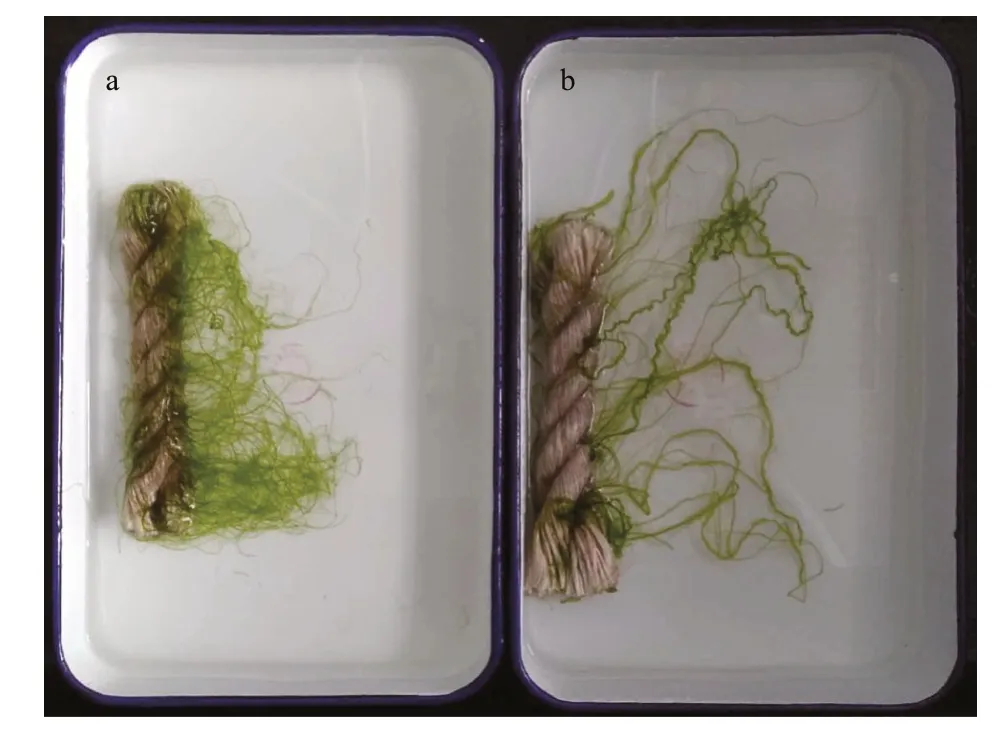
Fig.4 Photos of Ulva germlings grown on nylon rope stems cultured in the laboratory for 3–4 weeks
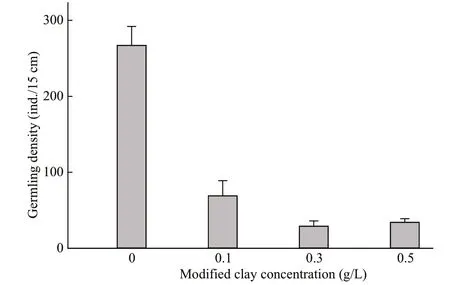
Fig.5 Ulva germlings grown on the nylon rope stems in four treatments after 3–4 weeks of cultivation in the laboratory
Twenty-four hours after the removal experiment was performed, nylon stems in the experimental vessels were sampled and incubated under laboratory conditions for 3–4 weeks. Ulva seedlings adhered to and grew on the stems (Fig.4). Enumeration of the seedlings using a stereomicroscope revealed that in the control group, the density of algae seedlings attached to nylon stems was as high as 267 ind./15 cm of rope. In the experimental group, the addition of 0.1 g/L of MC led to a reduction in density to approximately 69 ind./15 cm of rope, which was signifi cantly lower than that in the control group ( P=1.28×10-23; n=18). Higher doses of MC have a stronger restriction effect on the density of green tide algae that attached to stems. For example, 34 ind./15 cm of rope of Ulva seedlings were counted in the 0.5 g/L MC experimental group, which was signifi cantly lower than that in the 0.1 g/L MC group ( P=1.51×10-6; n=18; Fig.5).
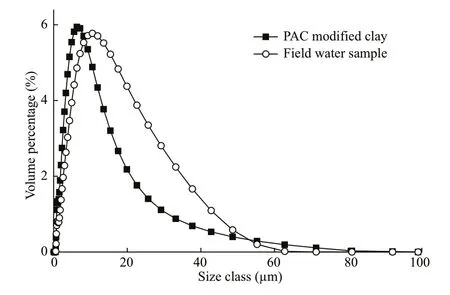
Fig.6 Particle size distributions of the PAC-MC and fi eld water samples
3.3 Particle characteristics of the MC solution and fi eld sea water
3.3.1 Particle size
The particle size distribution in the water samples collected from the experimental fi eld site was quite similar to that of the MC. As shown in Fig.6, 5.94% of the particles in the PAC-MC were 6.3 μm in diameter, and had the highest volume percentage. Moreover, most suspended particles in the fi eld water sample were 10.5 μm in diameter, comprising 5.77% of the total. Particles that were 0–50 μm in diameter accounted for >90% of the total particles present in both samples.
3.3.2 Zeta potential
The zeta potentials of the MC particles, fi eld water samples, UMPs and UMPs-MC flocs were tested. As shown in Fig.7, the zeta potential of the MC solution was 69.8±1.3 mv when diluted with ultrapure water but was 7.7±0.3 mv when released in the seawater. In comparison, the zeta potential of seawater collected from Zhugensha was -10.9±0.2 mv. Microscopic propagules were introduced from Ulva prolifera thalli and collected in the laboratory as described in Section 2.7. The zeta potential of these UMPs was -10.1±0.2 mv. MC was added to the UMPs culture and thoroughly mixed; then, the zeta potential of the well-resuspended mixture of MC and UMPs was 0.5±0.3 mv.
4 DISCUSSION
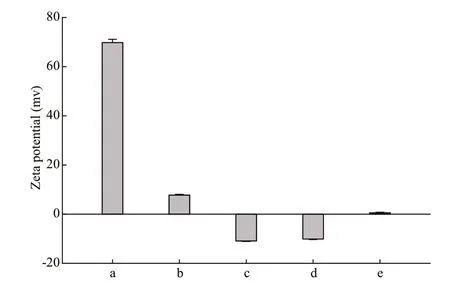
Fig.7 Zeta potential of modifi ed clay diluted in ultrapure water (a), modifi ed clay diluted in fi ltered seawater (b), suspended particles in the water sample collected from the Zhugensha sandbank (c), UMPs introduced and collected in the laboratory (approximately 4 000 cells/mL) (d), and the well-suspended mixture of modifi ed clay (0.3 g/L) and UMPs (4 000 cells/mL) (e)
The effectiveness of MC for removing UMPs has been repeatedly demonstrated. For example, a laboratory experiment showed that PAC-MC at 0.4 g/L could flocculate 83.3% of the UMPs at a density of 4.8×105ind./mL within 4 h (Li et al., 2015). Moreover, aluminum sulfate (AS)-MC, a kind of less studied MC, showed higher removal rate when applied at the same dose as PAC-MC (Zhang et al., 2016). During a ship-based experiment in the southern Yellow Sea, where the UMPs density (approximately 1 000 ind./mL) was much lower than that in laboratory simulation, >80% of the UMPs were removed from the water column after an MC application at 0.1 g/L. Moreover, > 0.3 g/L of MC removed 97% of the UMPs from the water column (Li et al., 2017). In this study, approximately 53% of the UMPs were removed from the water column in the experimental group treated with 0.1 g/L of MC for 24 h, while 75% were removed in the 0.3 g/L MC group. There was clearly a gap between the removal efficiency of MC when used in the ship-based experiment and in this fi eld mesocosm trial. It was suspected that the existence of a large number of suspended particles in the experimental sea area restricted the removal efficiency of MC on the UMPs.
Flocculation between algal cells and MC is essentially a result of electrostatic attraction between different particles (Yu et al., 1994, 2017). Particle size and surface electrical potential are among the main factors affecting the flocculation efficiency. Theoretically, similar particle size will increase collision efficiency between particles, and surface electrical attraction or repulsion, to some extent, will determine whether flocculation occurs after mixing of different dispersions. Generally, algal cells have negatively charged surfaces (Pieterse and Cloot, 1997), while MC particles are positively charged. They are attracted to each other by Van der Waals forces and are deposited as flocs grow larger and heavier (Yu et al., 2017). Measurement of the zeta potential (Kirby and Hasselbrink, 2004) showed that both the UMPs and suspended particles in the water of the study sea area were electronegative. Apparently, MC can effectively flocculate UMPs, which was consistent with the zeta potential analysis. At the same time, the suspend particles in the experimental sea area have similar size and opposite surface electrical potential compared with MC particles. Accordingly, these suspended particles would attract and electronically neutralize a portion of the MC particles that were added, and consequently decrease the chance of flocculation between the UMPs and the active MC particles. This phenomenon explains why a higher dose of MC was needed in this mesocosm experiment to achieve a similar UMPs removal rate as in the laboratory simulation and ship-based experiment.
In the control group, the UMPs density also decreased signifi cantly, and the proportion was similar to that in the experimental group to which 0.1 g/L of MC was added; however, further results suggested that the mechanisms involved in reducing the UMPs density were different. After 3–4 weeks of cultivation in the laboratory, 267 ind./15 cm of Ulva germlings, which was approximately four times of that in the experimental group, grew out on the nylon ropes in the control group. The prepared adhering base, several 15 cm long nylon rope stems, provided negligible area for UMPs to adhere. However, the fi berglass tanks used in this study were 1.6 m deep and 1.6 m in diameter, provided approximately 7 m2area for UMPs to adhere, which is apparently much bigger than that on the nylon ropes. It is reasonable to assume that more UMPs would adhere to the walls of the experimental vessel than to the nylon ropes. A portion of the UMPs would also naturally settle to the bottom of the water column together with some of the suspended particles. In summary, adhesion of UMPs to the nylon ropes and the experimental vessel wall and its natural settlement eventually lead to the decrease in UMPs density in the control group.
Previous studies suggested that flocculation between algal cells and their settlement would complete within 6 h (Li et al., 2019), which means that, in the experimental group, most of the UMPs would have been flocculated and settled by MC, before they can fi nd proper adhering base. In the experimental group that treated with 0.1 g/L of MC, only 69 ind./15 cm of nylon rope of green algae seedlings grew after 3–4 weeks of cultivation in the laboratory. In contrast, the number was signifi cantly higher in the control group, which was 267 ind./15 cm of nylon rope, as illustrated in Section 3.2.
Regarding the UMPs that settled to the benthic environment by MC, a previous study found that their germination rate also decreased. To assess their germination rate, the water column was thoroughly remixed 6 h after the addition of MC during the shipbased experiment and sampled. After 2 weeks of cultivation with enriched nutrients in the laboratory, the Ulva germination rates were 49.6%, 24.5%, and 0.3% of those in the control group when the MC concentrations were 0.1 g/L, 0.3 g/L, and 0.5 g/L, respectively (Li et al., 2017).
The inhibition of UMPs germination by MC was suspected to be caused by (1) the shading effect of MC particles; (2) biochemical injuries at the cellular and molecular levels; and (3) physical contact between algal cells and clay particles during the flocculation and sedimentation process. Liu et al. (2012) found that when the irradiance level was lower than 20 μmol photons/(m2·s), no germlings were observed after 18 days of culture, while germlings that were approximately 120 mm in length were observed in experimental groups that were irradiated with 120 μmol photons/(m2·s) or higher. When the UMPs settled to the bottom of the water column after the MC application, the light intensity that they were exposed to would signifi cantly decrease because of shading by the MC and other suspended particles and the increased depth; accordingly, it is reasonable to assume that their germination and growth would be inhibited. At cellular level, the enzymatic activities of superoxide dismutase, catalase, and ascorbic acid peroxidase in Chlorella vulgaris increased rapidly after an MC application (Liu et al., 2017), suggesting that peroxidation injury was caused by changes in the hydrochemical environment or physical contact. Further studies that were conducted to investigate transcriptional-level influences indicated that the stress inflicted by MC on residual cells induced them to increase physiological activities involved in survival and self-repair, inhibiting normal division and proliferation (Yu et al., 2017).
Up to now, the results of laboratory experiments, ship-based studies, and fi eld mesocosm trials both supported that MC can remove UMPs from enclosed water column with considerable efficiency, and consequently inhibit its germination (Li et al., 2015, 2017; Zhang et al., 2016). However, several practical issues need to be addressed before this method can be applied in the open seawater on Subei Shoal. First, potential toxicity of MC on non-target organisms, including the mariculture seaweeds and some local aquatic animals, should be tested through gradient experiments. Secondly, frequent and intense water exchange on the shoal might cause gradual decrease in the MC concentration; therefore, larger time-spacescale fi eld experiments are needed to verify the effectiveness of this method under certain hydrographic conditions. Besides, there were many other strategies that can potentially limit the accumulation of Ulva biomass on Subei Shoal, e.g. ingestion of UMPs using fi lter-feeding shellfi sh, coating of the rafts with antifouling materials, or harvest of the seaweed curtains at earlier stage. Comparative studies should be carried out regarding the economic cost and practicality of different strategies when applied in the fi eld.
5 CONCLUSION
The results of the fi eld mesocosm experiment conducted on Subei Shoal indicated that the application of MC could effectively remove UMPs from the water column and suppress their adhesion and germination on nylon ropes used for mariculture rafts. The removal efficiency was considerable, however lower than that observed in laboratory studies due to the existence of negatively charged suspended particles in the water column. Using MC to flocculate UMPs is a promising strategy to decrease the biomass accumulation of Ulva spp. on Subei Shoal. However, larger time-space-scale fi eld experiments under certain hydrographic conditions are needed to assess the effectiveness, the influence on non-target organisms, and the economic cost of this method before applied in the open sea.
6 DATA AVAILABILITY STATEMENT
The raw datasets generated during and/or analyzed during the current study are available only within this article.
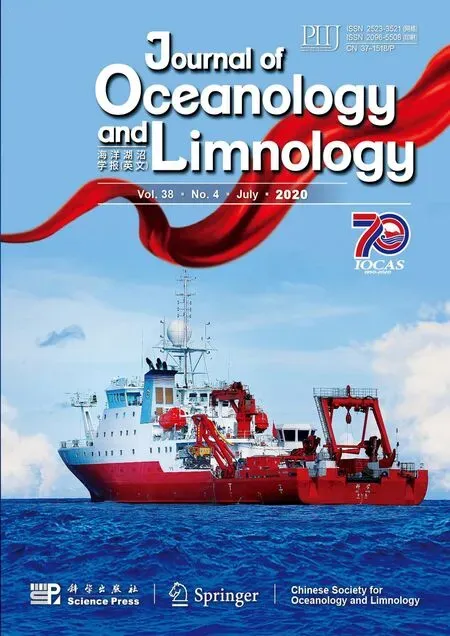 Journal of Oceanology and Limnology2020年4期
Journal of Oceanology and Limnology2020年4期
- Journal of Oceanology and Limnology的其它文章
- Review on observational studies of western tropical Pacifi c Ocean circulation and climate*
- Research progress of TiO 2 photocathodic protection to metals in marine environment*
- Smart anticorrosion coating based on stimuli-responsive micro/nanocontainer: a review*
- Status of genetic studies and breeding of Saccharina japonica in China*
- To be the best in marine sciences*
- A review of progress in coupled ocean-atmosphere model developments for ENSO studies in China*
